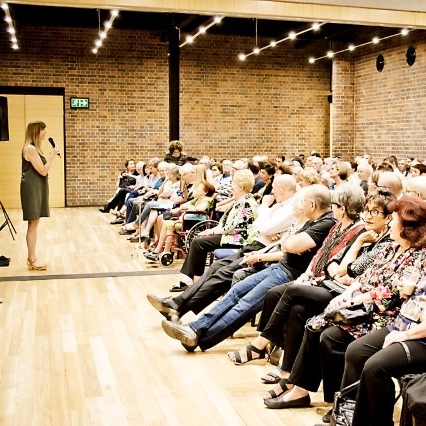click to dowload our latest edition
CLICK HERE TO SUBSCRIBE TO OUR NEWSLETTER


Published
6 years agoon
By
adminSTEVEN GRUZD
Germany today boasts a thriving Jewish community that’s 250 000 strong, and is a dependable ally to Israel. It has paid out millions of euros in compensation claims to Shoah survivors. Thousands of tiny commemorative brass plaques, called solpersteine, adorn German pavements, recording the details of individual Jews who once lived in homes nearby.
An award-winning documentary, Germans and Jews, kicked off the activities for 2018 at Johannesburg’s Holocaust and Genocide Centre last Thursday. The film unearths the complex, multiple strata of evolving interactions between Germans and Jews across generations and cultures.
It revolves around a dinner party in Berlin, where second- and third-generation post-war Jews and Germans have frank, difficult conversations, intercut with interviews conducted with historians, psychologists and other Germans and Jews.
It portrays the vibrant Jewish scene in Berlin, with its eclectic mélange of ex-Soviet refuseniks, Jews from other European countries, a growing Chabad presence and Israeli hipsters and artists feeding off the energy of one of the world’s trendiest cities.
Tali Nates, director of the Holocaust and Genocide centre, said one of the centre’s aims was to challenge preconceptions. Calling the film “thought-provoking”, she went on to highlight the themes of memory, identity, guilt and the psychology of a country operating in different eras.
Nates sees the relevance of this film for South Africa today. “Now, 24 years into democracy, we are struggling with many of these issues, such as memory, intergenerational differences and victimhood. How do you remember the story? How do you tell it? How do you educate others about the story? We are very much at the same point as the former West Germany was. As the film showed, the students of 1968, 23 years after the war, finally asked their parents: ‘What did you do?’ We’re there. And our students are asking the same questions.”
Born in 1953, Dr Norbert Spitz, director of Johannesburg’s Goethe Institute, said the film echoed his generation’s experience. He said that in the 1960s, there was no concept in the German education system of how to teach the Holocaust. “So, it was not taught. History started with Hitler’s election as chancellor in 1933, and continued with the creation of the Federal Republic [former West Germany] in 1949.”
The Adolf Eichmann trial in Israel in 1961, and the war crimes trials in Frankfurt in the mid-1960s, saturated the German media. Spitz, like other students, started questioning what had happened, asking his own parents and teachers what they did in the war.
“This film had a comprehensive, realistic approach to a very complex issue. Throughout, you see how perspectives changed as generations and the context changed. I never felt guilty, but I feel a huge responsibility as a German to see that the knowledge is there and that this never happens again,” Spitz said.
Other European countries have failed to fully face their ugly past the way that Germany, eventually, did. Nates contends that the iconic book, The Diary of Anne Frank, spawned a national myth of the Dutch as heroic Jew rescuers. “But we now know that betrayal of Jews in the Netherlands was high, and the percentage of Dutch Jews deported was the highest in Western Europe.”
Felix Sjögren, 14, living in Pretoria with his Swedish diplomat parents, said of his experience of the movie: “It was interesting to see the contrasting views of Israelis and of other Jews living in Germany, along with the experiences of other Germans.” Sjögren added that this was an important film especially for young people to see.
After World War II ended, and as more research emerged about the Holocaust, young Germans faced up to the past of their families. “I belong to a generation that was brought up without any national symbols,” Spitz admitted. “Even traditional folk songs were no longer sung, because they had been abused by the Nazis.”
He said the 2006 FIFA World Cup marked the first time “it was legitimate to have a German flag outside your house”.
Spitz added that some Jewish fear or hatred of Germans was understandable, but urged the public to “come and look at Germany today”.
He admitted that ensuring that the notion of “never again” held fast was was getting increasingly difficult. “The victims and the perpetrators die away, and it becomes a fact in history books.” Hence the importance of films like this.
Nates said: “Germany has a lot to teach us in South Africa about struggling with identity and history.”
Let Hitler vomit in his grave as he sees a giant Chabad Channukiah towering over the Brandenburg Gate in Berlin. That’s karma for you.
